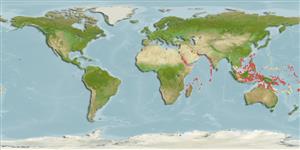|
Scleractinia |
Merulinidae
Environment: milieu / climate zone / depth range / distribution range
Ecologie
Rifbewoner; diepteverspreiding 0 - 20 m (Ref. 98471). Tropical
Northwest and Western Central Pacific: Hong Kong, Malaysia and Indonesia.
Length at first maturity / Size / Gewicht / Leeftijd
Maturity: Lm ? range ? - ? cm
Colony: submassive to encrusting. Corallites: deep, with very thin angular walls giving colonies a honeycomb appearance. Corallites: usually less than 7 mm across. Septa: few, widely spaced. Absent paliform lobes. Colors dark, often with white upper margins to walls (Ref. 848).
Occurs in shallow reef environments (Ref. 848). In lagoons and on the back and foreslope of the reef (Ref. 98471).
Life cycle and mating behavior
Geslachtsrijpheid | Voortplanting | Kuitschieten | Eieren | Fecundity | Larven
Members of the class Anthozoa are either gonochoric or hermaphroditic. Mature gametes are shed into the coelenteron and spawned through the mouth. Life cycle: The zygote develops into a planktonic planula larva. Metamorphosis begins with early morphogenesis of tentacles, septa and pharynx before larval settlement on the aboral end.
Wijsman-Best, M. 1976. (Ref. 83538)
Status op de Rode Lijst van het IUCN (Ref. 130435)
Status bij CITES (Ref. 108899)
Not Evaluated
Gevaarlijk voor mensen
Harmless
Gebruik door de mens
| FishSource |
Tools
Meer informatie
Leeftijd/GrootteGroeiLengte-gewicht parametersLengte-lengte parametersMorfologieLarvenAbundantie
Internet-bronnen
Estimates based on models
Preferred temperature
(Ref.
115969): 27.1 - 29.2, mean 28.8 (based on 626 cells).
